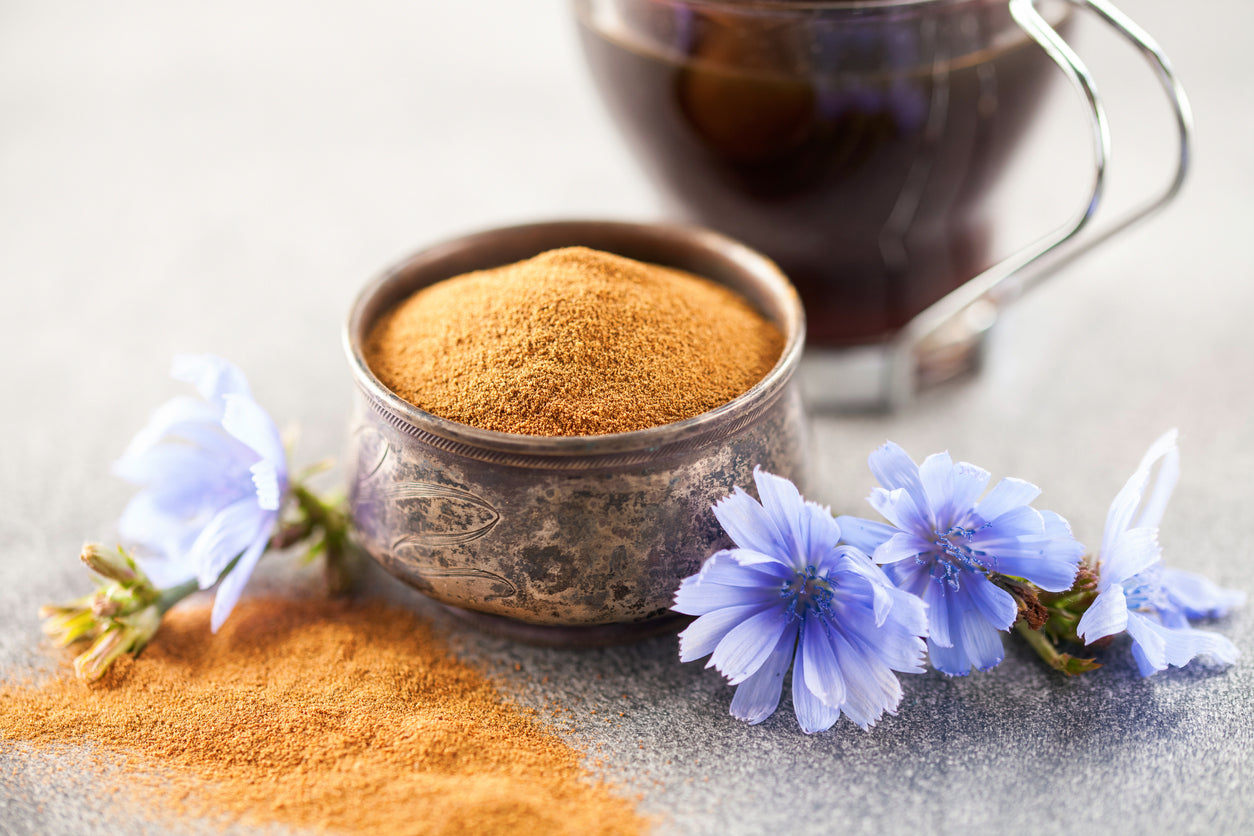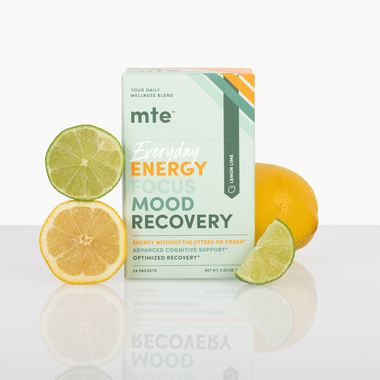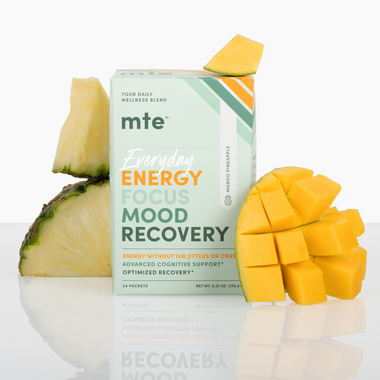
Chicory Root: A Superfood with Staying Power
One of the 11 holistic ingredients in MTE, chicory root is a multitalented superfood that complements our powerhouse wellness blend of adaptogens, nootropics and superfoods. You’ve probably seen the chicory plant before, and you’ve definitely heard about it in the world of gut health supplements. But what is it, exactly? And why does it have so much clout in the vitality industry?
The chicory plant (Cichorium intybus) is a tall, leafy, flowering plant in the daisy family. It grows wild – you’ve probably seen its daisy-like blue, white or pink flowers. The leaves are often used in boujee salads and other trendy whole-food-style things. But the fibrous roots are where the magic is really at, which is why you’ll mostly hear it referred to as chicory root, and not just chicory.
Historical & Traditional Uses of the Chicory Root
It’s claimed that chicory was first cultivated in Egypt around 5000 years ago for liver and heart support, but there’s little more than anecdotal evidence to support that. Not to say it’s out of the question – by the time we get to the Greek-dominated ancient world, chicory is mentioned in many pharmacopoeias, and continues to be right up to modern times. It had to come from somewhere!
The experiential evidence chicory root has accumulated over the last 2300+ years spans continents, contexts and belief systems. Some traditional uses of the chicory plant include:
- In Afghanistan, immune tonics of chicory root extracts were used to treat malaria.
- Traditional Indian medicine used different parts of the chicory plant for liver disorders, diabetes, cough, gout, and rheumatism.
- In Italy, chicory leaves and roots were used for vascular support, including blood cleansing, blood pressure and vascular conditions.
- In Poland, chicory roots were steeped as a tea and used for digestive problems and appetite stimulation.
- In South Africa, all parts of the chicory plant were used to treat jaundice.
- Traditional uses for the chicory root in Turkey include cancer, kidney stones, wound healing, hemorrhoids, and urinary disorders.
Chicory root is definitely having a modern moment, but it’s been millennia that physicians, botanists and even poets have been singing its praises. And while an aeon of indigenous knowledge from across the world supports the skills of this superfood, today’s Western world loves receipts. So let’s get into the compounds, mechanisms and studies that support the many health benefits of chicory:
Clinical Evidence for the Benefits of Chicory Root
Over 100 distinct bioactive compounds have been identified in the chicory plant, most of which are concentrated in the roots. The main one you’ll hear is the fiber inulin, which is a known MVP for organic gut support, but there are a bunch of other good things going on in there, too. Bioactivities of chicory that are supported my modern science include:
Antimicrobial
In lab settings, several organic acids contained in the chicory root have shown an ability to inhibit bacterial adhesion to cells, as well as the biofilm formation that comes with bacterial infestation. Chicory root extracts have also demonstrated inhibitory effects on disease-causing organisms including salmonella, E. coli and micrococcus. Leaf, seed and root extracts have shown particular abilities against several drug-resistant viruses, fungi and parasites.
Digestive Support
The tannins and lactones in the chicory root have shown distinct benefits to digestion and gut biome in studies on grazing animals. Benefits include reduced gastrointestinal disorders and increased digestive function. Chicory root supplements have also shown an anti-worm ability in several types of grazing mammals, and gastroprotective properties in rats.
Antimalarial
This is a super-salient example of traditional uses being confirmed by clinical analysis. If you recall, chicory root extracts were used in Afghanistan to treat malaria. Modern studies have confirmed the anti-malarial activity of the chicory root via its bitter compounds – namely, lactulin and lactucopricin.
Liver & Immune Support
Many of the traditional medicinal uses of chicory have been as a hepatoprotectant, and clinical literature supports these uses. One double-blind, placebo-controlled study on the effects of chicory in patients with liver cirrhosis reduced several harmful markers and demonstrated anti-oxidative, diuretic, anti-inflammatory, and immunomodulatory properties. Several other studies have shown chicory root extracts drastically reduce fat accumulation and necrosis in animals with liver disease.
Other Supported Benefits
There are a host of other capabilities of the chicory plant modern science has uncovered or confirmed. They include:
- Anti-diabetic/blood sugar regulation
- Anti-inflammatory
- Analgesic/pain relief
- Antioxidant
- Antitumor
- Antiallergenic
Chicory root has also demonstrated anti-toxicity activity, restorative activity in several immune system markers, inhibitory effects on lymphocyte production, wound healing effects, and an ability to reduce stress symptoms on the heart.
Is that enough stuff?
Why Gut Health Matters so Much
Digestive health isn’t just about a calm stomach and regular movements. You may have heard the gut referred to as a “second brain”, and there’s some weight to that argument. Not only does your digestive system have its own nervous system, it can also operate autonomously from your actual brain. So it’s not to be overlooked when you’re considering wellness.
The community of bacterias in your gut, referred to as a microbiome, is all important in those gut-brain parlays. Prebiotics and probiotics foster a diverse community, which creates homeoestasis. An unbalanced microbiome, on the other hand, can mess with digestive signaling and indirectly mess with mood, energy levels, and even immune system function.
For a deep dive article on the gut, check out: The Gut-Brain Connection: Is Your Gut Really a Second Brain?
The TL;DR of it all is we didn’t just throw chicory root in there to add another item to the long list of MTE’s benefits. Supporting gut health is necessary to support vitality, which is what our daily wellness blend is all about. That and a caffeine-free energy boost - gotta love the ability to get energy without caffeine and all its issues.
Is Chicory Root a Safe Superfood?
On top of all that, a review of the literature supporting all these uses of the chicory root cites several toxicity studies on chicory supplementation. Studies showed no toxic or mutagenic effects in animals, and the scientific community generally agrees chicory safe for human use even in high doses. However, chicory root isn’t recommended for everybody –
You should consult a physician before adding chicory to your daily supplement routine if you:
- Have a gallbladder or liver condition
- Kidney disorder
- Gastroesophageal reflux disease
- Diabetes
- Are on certain medications
People who should avoid chicory as a wellness additive include:
- Children
- People with a ragweed allergy
- People who are pregnant/nursing
MTE’s Trio of Superpowered Superfoods: Chicory, Amaranth & Spirulina
More Than Energy is a daily greens blend – a pared-down, plant-powered wellness companion for fatigue, mood, digestion, immunity, energy, focus, recovery, and more. Of the 11 clean, bioactive ingredients in MTE, chicory root is one of three key superfoods we use to support the adaptogens and nootropics in our formulation. The other two are amaranth – backed for cardiovascular support, immune support, antioxidant activity, and more; and spirulina – backed for energy, nutrition, anti-inflammatory activity, and more.
The ingredients in our proprietary daily wellness blend make up more than the sum of their parts, adding up to overall wellness support for vitality, and just feeling better! Check it out.






